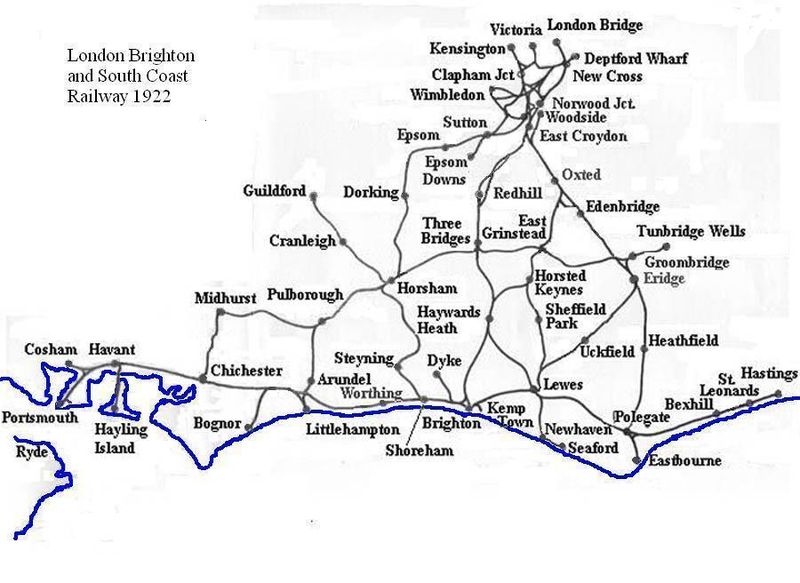
1922
The Southern Belle of the of the 1920’s was a heavy train of anything up to nine carriages and on one occasion eleven carriages was recorded. In 1922, the last year of the L.B.S.C.R.
being an independent company there was no less than fifty four Pullman car trains, which was ten more than in summer of 1914.
Great changes were brought about the amalgamation of 1923 with familiar initials of the
L.B.& S.C.R. disappearing and being replaced by the Southern Railway. On the 31st
December 1924 the surviving twelve wheeled Pullman carriages made their last run as part of the Southern Belle. The following day they were replaced by an entirely new train of modern eight wheeled carriages. The old carriages migrated to various parts of the system, and during the 1930s a number of them were used in special race trains running from Victoria to Epsom Downs for the Derby.
In February, 1926, a first class Pullman carriage was reinstated on the ‘City Limited’, after
being a non Pullman train since 1924.
The Brighton Atlantics and Baltic tank locomotives were gradually taken off the Southern
Belle and replaced by the south Western King Arthur class which was finally replaced when
electrification arrived..
It is with deep regret I have to report the death of Bro. F. Wilson, who passed away after a
brief illness, at the age of 51. It came as a great surprise to the whole of the members of the
Branch. He was greatly respected by all. The funeral took place on the 2nd of March, 45
members followed him from his residence to the cemetery, and six members acted as bearers
from the chapel to the grave. He was a member of the Assurance Fund, and the window
wishes to thank in which the claim was settled.
THE LAST L.B.S.C.R. LOCOMOTIVE
TO BE BUILT AT BRIGHTON WORK
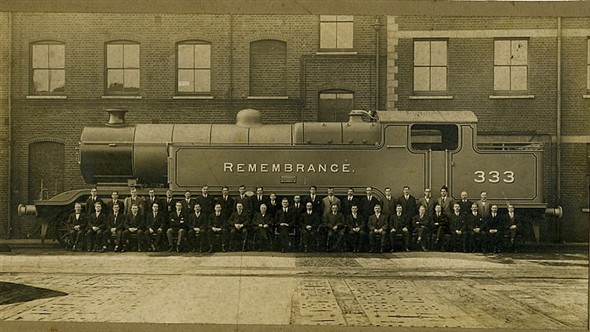
PHOTOGRAPHER UNKNOWN
The naming ceremony of the last Brighton built locomotive to be produced by
the L.B.S.C.R.
L. Class “Baltic Tank" locomotive at Brighton locomotive works No. 333
Remembrance in April 1922
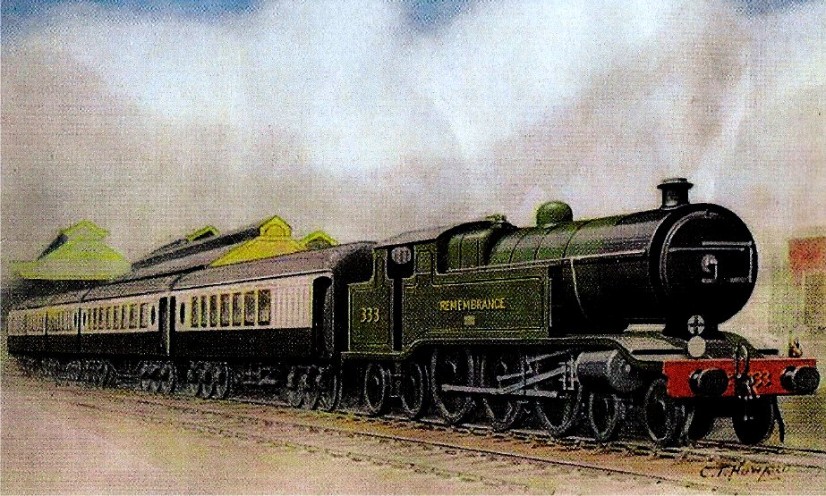
REMEMBRANCE 333 "L CLASS" (Baltic Tank 4-6-4T) was the last steam engine to be built by the London Brighton & South Coast Railway at Brighton in April 1922. The
Remembrance locomotive was named in honour of the 532 L.B.S.C.R railway men who lost their lives during the First World War. The engine was allocated to Brighton based Engine-drivers Fred Horsman and Harry Funnell, who worked on the Southern Belle service between Brighton and London.
Following the electrification of the main London to Brighton the "L CLASS" locomotives
were to be designated to work on the express trains between London to Eastbourne.The “L CLASS" locomotives were to be withdrawn from service at the end of 1934. Remembrance was withdrawn from service on the 7th December 1934. This was due to the electrification of the line Between Keymer Junction to Eastbourne and that there was no other suitable work for the “L CLASS" locomotives. This was owing to restrictive route availability placed on this class of locomotive. With no other suitable work being available within the Brighton section of the Southern Railway the "L CLASS" was withdrawn. Remembrance along with the other six engines of this CLASS were sent to Eastleigh works to be rebuilt into CLASS N15x (REMEMBRANCE CLASS 4-6-0) locomotives.
Remembrance re-entered service on 27th June 1935 and along with the rest of her Class
they spent the rest of their working lives on the South Western section of the Company,
working semi fast trains between London Waterloo and Basinstoke. These locomotives
were finally withdrawn from service by British Railways in 1956 and Remembrance was
withdrawn at Brighton on 4th April 1956 after working a special train to Brighton.
The Remembrance name plates are on display at the National Railway Museum at York
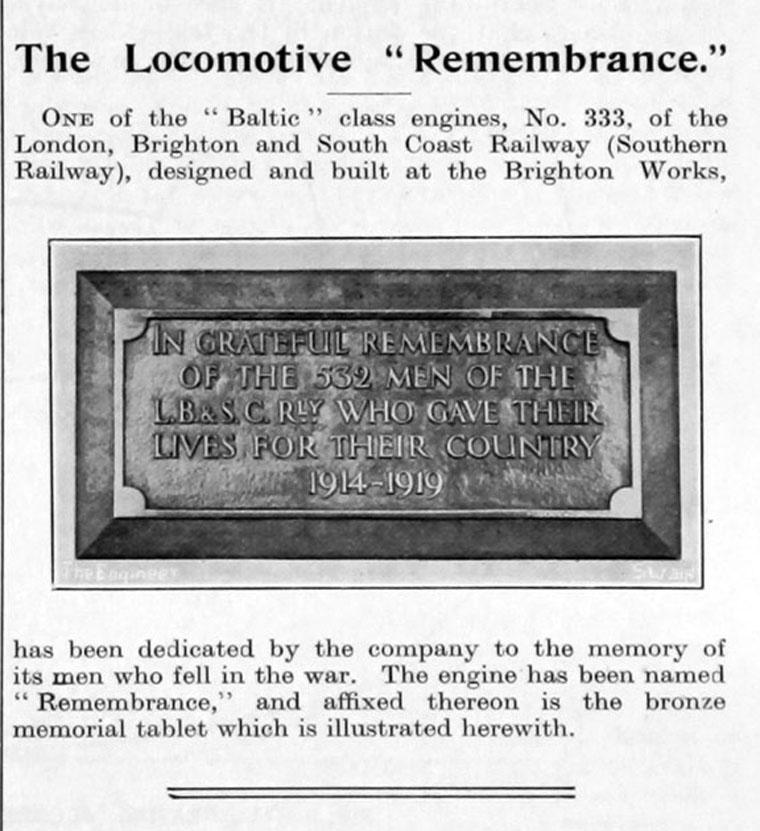
Known L. B. & S. C. R. Enginemen who fell in the First World War
It is with deep regret I have to record the death of one of our members, Bro. James Charles
Turk, who met a fatal accident while firing on a motor train between Brighton and Worthing, on Saturday, September 2nd. The funeral of our late Brother took place on Thursday, September 7th, when about 80 Drivers and Firemen followed him to his last resting - place, six of them acting as bearers; also, about 20 attended from the Traffic Department. The coffin and hearse were covered in wreaths, and a cab was engaged to take the remainder, there being 54 in all. It was a very impressive sight, and crowds of people showed their sympathy by standing while the cortege passed. Our late Brother joined up in the R.F.A. during the war, and some splendid wreaths were sent from the regiments with which he served in Mesopotamia. Our deepest sympathy goes to his relatives, also to the young lady to whom he was shortly to have been married.
BRANCH SECRETARY
*James Turk was known to many as Jack,
his regular driver at the time of his accident was Harry Thompson
Wrong place, wrong time – Mrs Quelch
Sometimes someone is simply in the wrong place, at the wrong time. On 30 September 1922, Mrs Quelch was one of those people.
Her case is interesting in its own right, as we shall see. It also demonstrates something important about our database: not everyone featured in the database was a railway worker. Plenty of people had reason to be around the railway, and thus exposed to danger – merchants delivering or collecting goods, postal workers, farmers, dockers, and more.
On the other hand, Mrs Quelch had the dubious distinction of simply being a passer-by, injured when a steam engine crashed through a wall.
The accident took place at Brighton engine shed, on the London, Brighton and South Coast Railway (LBSCR). Driver John Yeates took his engine to the turntable, at the north end of the shed and yard. As the map shows, the turntable was tucked up against a public road; the road was separated from the railway by a brick wall around eight feet high. As Inspector John Main noted, there weren’t any buffer-stops on the rails leading from the turntable towards the street. Instead the rails were turned up through 90° in a curve, to form a barrier of sorts.
Yeates, who was noted as ‘an experienced driver’, moved his engine onto the turntable. In order to balance the turntable it was important to get the loco as close to central as possible – in this case a 50foot engine on a 60ft table. Yeates initially went a bit too far, so reversed … only to go a bit too far in the other direction. He tried to even up again – but as there was steam retained in the cylinders, it ‘drove the engine backwards through the rail stops against the wall, which was thrown down.’
The report noted that ‘Mrs. Malcolm Quelch, who was passing along the side walk at the time’ was hit by bricks from the wall, injuring her foot. The eagle-eyed of you will note two things. Firstly, that Mrs Quelch was not given the courtesy of her own name but her husband’s, in keeping with the social conventions (for some) of the time. Secondly, the use of ‘side walk’ was unexpected – we thought this was confined to our American cousins.
Main’s report concluded that ‘the accident and damage were directly due to a lack of care by Yeates’. The infrastructure provided – the lack of more effective buffers – by the Company was only noted as being ‘incidentally’ involved, even though they were ‘quite inadequate’. The LBSCR was recommended to replace them with ‘some more efficient and substantial form’ (1922 Quarter 3, Appendix B).
As ever, we know a little more by going a bit wider than the accident investigation report. The only press report of the accident we’ve been able to find, from the Daily Herald, featured the case under ‘Rail engine’s prank’ – Mrs Quelch might have felt otherwise. According to the report – rather less dry than the official investigation, as we might expect – ‘a great chunk of wall […] crashed’ into the street. Margaret Quelch, 30, was identified. She had her big toe amputated as a result, and the puppy she was carrying in her arms died. Possibly this part of the report was more accurate than the understanding of railway practice: ‘it seems an engine was being moved on a turntable […] when it swung round too far and struck the wall’ (Daily Herald, 2 October 1922, p.5). Close, but not quite right!
As to Margaret Quelch – well, we thought with a reasonably distinctive surname it would be a fairly straightforward task to identify her. Needless to say, that wasn’t the case. There were a fair few Quelchs around, and of course the was a Margaret AND a Margaretha who had married a Malcolm Quelch in the Brighton area! We believe the right person to have been Margaretha, born in 1892. She and Malcolm had two children; by the time of the 1939 Register, Malcolm had died, and one of the their children was still living with Margaretha.
So, in many ways a remarkable case, with a comparatively small personal impact – but one which illustrates some important facets of our database and the work we’re doing.
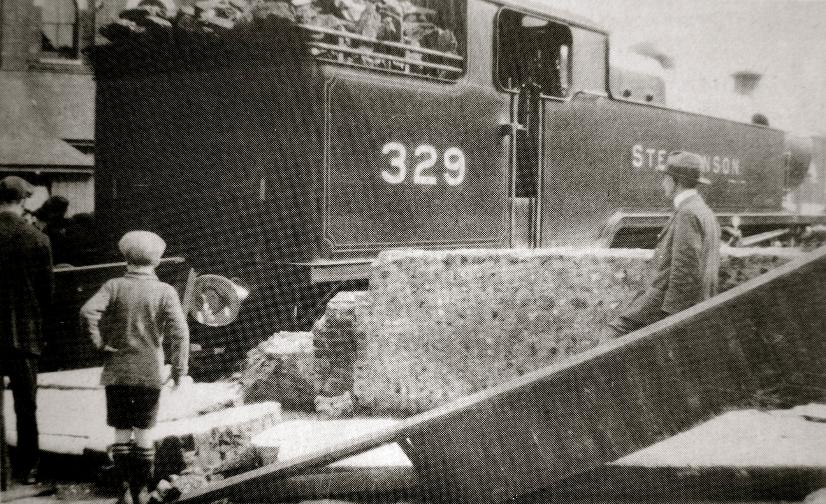
Stephenson comes to a halt demolishing the Brighton loco wall
On 30th September, 1922, Brighton Driver John Yeates was moving his engine No. 329, 'Stephenson,' on to the Brighton turn table. As often occurs the balance was wrong and before turning could commence, Driver Yeates had to reverse a short distance and then run slowly forward across the turn table until the engine's weight was correctly poised. Unfortunately, he forgot the superheater had to be taken into account and although the regulator was closed in time, Stephenson rolled majestically on and over the turn table, through an 8ft.-high brick wall crashed into New England Road injuring a passer by.
At the inquiry, Driver Yeates was severely criticised for driving a superheated engine within the shed precincts without having the cylinder drain cocks open and therefore not being in full control of its movement.
extracted and adapted from the book called
“The Brighton Baltics”
by A.C. Perryman
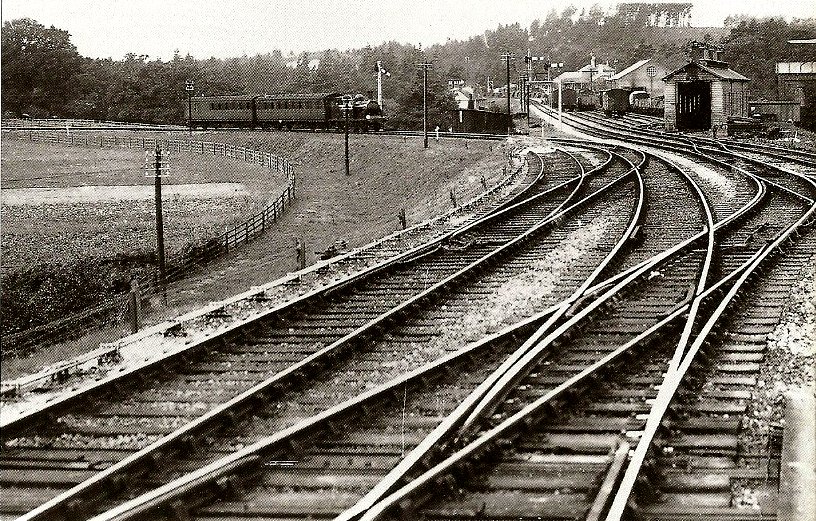
PHOTOGRAPHER UNKNOWN
This photo is looking west from Midhurst L.B.S.C.R. station in 1922.
The scene shows a up Chichester train approaching Midhurst and is signalled into the
L.S.W.R. station.
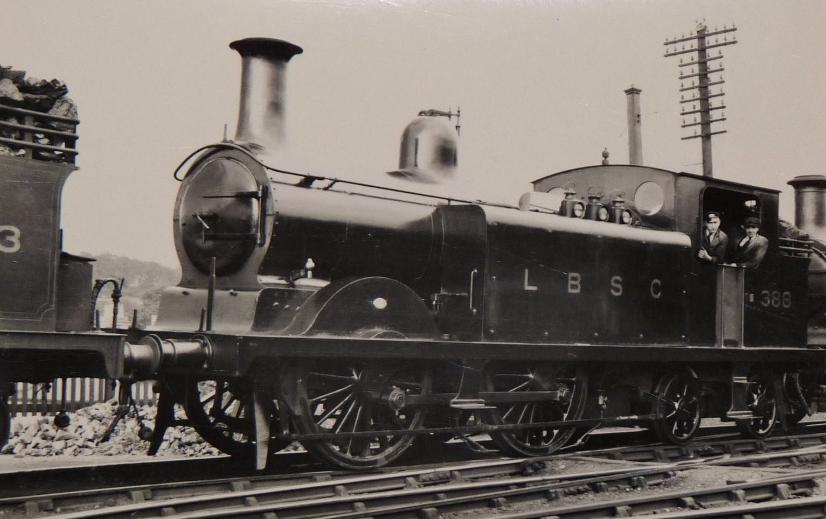
Mick White Collection
TUNBRIDGE WELLS Loco 1922
Railway accident on the
L.B.S.C.R.
THE END OF THE L.B.S.C.R.
At the stroke of midnight on Sunday 31st December 1922, the London Brighton & South
Coast Railway ceased to operate as an independent company and become part of the
Southern Railway.
